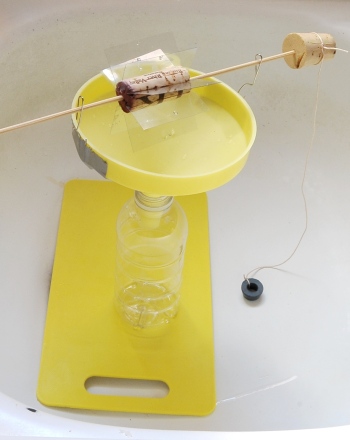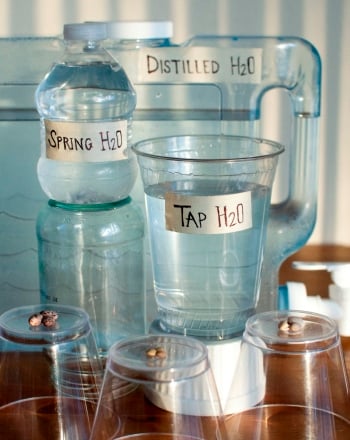Science project
Water Purification Experiment: Removing Chlorine From Water
Chlorine is a chemical added to water supplies to kill microorganisms. Microorganisms are tiny living things like bacteria, viruses, and protozoans that cannot be seen with the naked eye. Cholera, typhoid fever, and dysentery are all caused by microorganisms in water. Before chlorine was routinely added to water supplies, thousands of people died because of water-borne diseases. A disinfectant is a substance that kills microorganisms. One well known disinfectant is soap. Chloramine is another disinfectant that is often added to water supplies instead of chlorine.
Unfortunately, small animals, especially fish, are sensitive to chlorine and chloramine. Chlorine and chloramine can also react with compounds in the water, forming potentially hazardous new substances. This is why it is absolutely necessary to remove chlorine and chloramine from your tap water before setting up a fish tank.
Problem
What's the best way to remove chlorine and chloramine in water?
Materials
- Chlorine and chloramine test strips (combo strips that test for both and a couple other substances are available at pet stores)
- Tap water
- Swimming pool water
- Distilled water (available at grocery stores)
- Clean non-metal containers for holding water samples
- Stove
- 3 very clean pots
- Chemical dechlorinator (also available at pet stores, often called “water conditioner”)
- Carbon over-the-tap or carafe-type water filter
Procedure
- Follow the instructions for your chlorine/chloramine test strips to record the amount of chlorine/chloramine in each of your water samples. Make sure all your samples are the same temperature. Make a data table like this one:
|
Sample |
Initial Amount of Chlorine |
Initial Amount of Chloramine |
|
Tap water |
|
|
|
Distilled water |
|
|
|
Pool water |
|
|
- Now that you have some idea of how much disinfectant are in different sources of water, you can try different ways of removing the disinfectants from the tap water.
- Pour a sample of tap water into an open container and let it sit for 24 hours.
- Test the water for disinfectants, record in a second data table.
|
Tap Water Treatment |
Final Chlorine Amount |
Final Chloramine Amount |
|
Sitting |
|
|
|
Boiling |
|
|
|
Chemical Removal |
|
|
|
Carbon filter |
|
|
- Boil a pot of tap water for fifteen minutes. Let cool.
- Test the boiled water for disinfectants, record data.
- Treat a third sample of tap water with the chemical dechlorinator.
- Test treated water sample for chlorine and chloramine, record data.
- Use the carbon filter to treat a fourth sample of tap water.
- Test the carbon treated sample for chlorine and chloramine, record data.
Results
Your results will vary depending on your water sources. You are very unlikely to find either chlorine or chloramine in the distilled water. You are very likely to find either chlorine or chloramine in the pool water. You should find either chlorine or chloramine in the tap water; if you don’t, you need to find a source of tap water that does have the compounds for the second experiment, or you could do the treatment experiment on the pool water.
If you have chlorine in your water, much of it should disappear after sitting 24 hours or after being boiled. Chloramine, however, tends to remain after both sitting and boiling. Both the dechlorinator drops and the filter should remove both chlorine and chloramine.
Why?
Sitting allows chorine gas to escape the water and enter the air. Boiling accelerates chlorine’s escape into the air. Chloramine, however, tends to remain in water longer. Many water choramine to treat water and kill microorganisms. Both the carbon filter and chemical treatment react with chlorine and chloramine, removing them from the water.
Going Further
Try the treatments you did on the tap water on the pool water. Were sitting and boiling enough to remove the higher amounts of disinfectants? You can also find out about your town’s water supply. Where does the water come from? What disinfectants are added? See if the water department data matches your experimental results.
Education.com provides the Science Fair Project Ideas for informational purposes only. Education.com does not make any guarantee or representation regarding the Science Fair Project Ideas and is not responsible or liable for any loss or damage, directly or indirectly, caused by your use of such information. By accessing the Science Fair Project Ideas, you waive and renounce any claims against Education.com that arise thereof. In addition, your access to Education.com's website and Science Fair Project Ideas is covered by Education.com's Privacy Policy and site Terms of Use, which include limitations on Education.com's liability.
Warning is hereby given that not all Project Ideas are appropriate for all individuals or in all circumstances. Implementation of any Science Project Idea should be undertaken only in appropriate settings and with appropriate parental or other supervision. Reading and following the safety precautions of all materials used in a project is the sole responsibility of each individual. For further information, consult your state's handbook of Science Safety.













